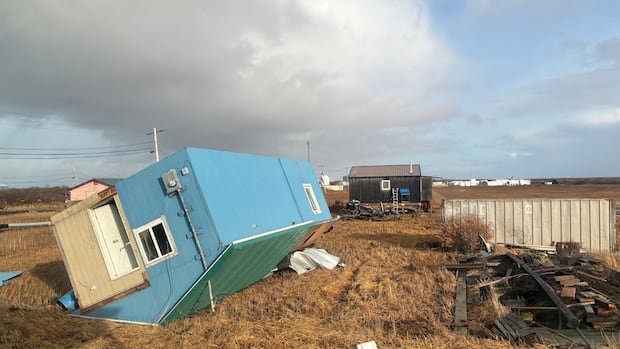In western Alaska, the aftermath of Typhoon Halong led to tragic consequences, with one person confirmed dead and two individuals still missing. The region was hit by powerful hurricane-force winds, storm surges, and flooding that resulted in the destruction of several homes. Over 50 individuals have been rescued, including some who were rescued from rooftops. Authorities have emphasized the long road to recovery ahead and highlighted the crucial need for ongoing support for the communities most severely impacted.
Captain Christopher Culpepper of the U.S. Coast Guard described the situation in the villages of Kipnuk and Kwigillingok as one of “absolute devastation.” Alaska State Troopers reported the successful rescue of at least 51 people and two dogs in these villages following the destructive storm. Both areas experienced significant storm surges, as confirmed by the National Weather Service.
Tragically, a woman was found deceased in Kwigillingok, with two individuals still unaccounted for in the same village. While there were initial reports of missing persons in Kipnuk, the troopers later confirmed that everyone in that area had been located.
According to the Coastal Villages Region Fund, the majority of residents in Kipnuk and Kwigillingok sought refuge in local schools during the crisis. Kwigillingok, home to around 380 residents, is a predominantly Indigenous community situated near the mouth of the Kuskokwim River on the western shore of Kuskokwim Bay.
The vulnerability of the low-lying region to flooding was highlighted in a 2022 report by the Alaska Institute for Justice, which noted an increase in both the frequency and severity of flooding in recent years. The urgent need for community relocation was underscored in the report.
In addition to housing issues, residents affected by the storm reported challenges such as power outages, lack of running water, spoiled subsistence foods, and damage to home-heating systems. This damage could complicate the upcoming winter for remote communities that rely on stored food from hunting and fishing to sustain themselves during the season.
Local residents recounted harrowing experiences during the storm, with Jamie Jenkins from Napakiak describing it as the most severe she had ever witnessed. She shared accounts of howling winds and rapidly rising waters that prompted her family and neighbors to seek safety together. Jenkins mentioned the collective effort within the community, with men using boats to rescue those still in their homes.
Adaline Pete, a resident of Kotlik, expressed astonishment at the unusually strong winds, noting an unoccupied house nearby that was overturned by the storm. Despite the chaos, Pete and her family found refuge in their own home.
During a press conference led by Governor Mike Dunleavy, U.S. Senators Lisa Murkowski and Dan Sullivan emphasized their commitment to climate resilience and infrastructure funding for Alaska. They stressed the importance of ensuring federal support for such initiatives, particularly in light of the increasing frequency and intensity of severe weather events in the region.
The ongoing threat of erosion and melting permafrost poses significant challenges to infrastructure and communities in Alaska, underscoring the urgent need for proactive measures to address the impacts of climate change.


